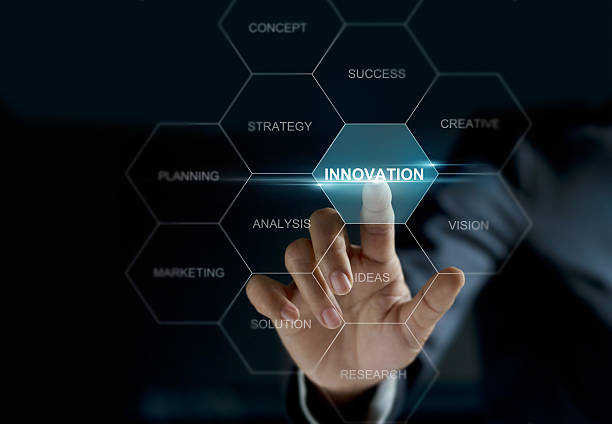In today’s fast-paced business world, innovation is no longer just an option; it has become a strategic imperative for any company seeking growth and excellence. Internal innovation programs are among the most effective tools for achieving this goal, enabling organizations to transform creative ideas into actionable projects that contribute to process improvement, product development, and increased customer satisfaction.
Moreover, Companies that implement robust internal innovation programs can adapt quickly to market and technological changes, giving them a sustainable competitive advantage. This article will outline the steps to successfully launch an internal innovation program, best practices for motivating employees, measurement tools to ensure results, and the role of senior leadership in supporting such programs.
Firstly: What is an internal innovation program?
An internal innovation program is an organizational framework designed to motivate employees to contribute new ideas and transform them into viable projects. This program encompasses not only product development but also improving internal processes and exploring new business management approaches.
On the other hand, The program serves as an effective channel for fostering a culture of innovation within the organization, where employees at all levels participate in providing innovative solutions. Consequently, innovation becomes an integral part of the organizational culture.
The importance of an internal innovation program
Achieving a sustainable competitive advantage: Through the program, the company can offer unique solutions and services that distinguish it from competitors.
Improving operational efficiency: The best ideas often come from the employees who deal with operations on a daily basis, leading to improved productivity and reduced costs.
Promoting a culture of belonging and motivation: Employee participation in creative decision-making increases their sense of responsibility and belonging.
Adapting to market changes: The program helps to deal with new opportunities and challenges quickly and effectively.
Attracting and retaining talent: A work environment that encourages innovation is attractive to the best talent in the market.
Second: The basic steps for launching an internal innovation program
1. Defining vision and goals
Before starting any program, it is essential to have a clear vision of what the company wants to achieve. For example:
Developing new products.
Improve customer experience.
Improving the efficiency of operational processes.
Promoting a culture of innovation within the organization.
In addition, the program’s objectives must be consistent with the company’s overall strategy to ensure senior management support and the sustainability of efforts.
2. Creating a culture that supports innovation
Innovation cannot flourish in a traditional environment that lacks experimentation and communication. Therefore, companies must:
Encouraging calculated risk-taking: Failure should be treated as an opportunity to learn, not as a punishment.
Providing a flexible and collaborative work environment: Open spaces and shared work systems promote the exchange of ideas between teams.
Recognizing creative contributions: Rewards and incentive programs encourage employees to submit their ideas.
Enhancing internal communication: Holding regular meetings to discuss new ideas helps spread a culture of innovation throughout all departments of the company.
Moreover, A supportive environment for innovation makes employees feel that their efforts are appreciated, which increases their loyalty and organizational commitment.
3. Building an administrative structure to support the program
The success of an internal innovation program requires a clear and dedicated organizational structure to manage it. This typically includes:
Innovation Manager: Responsible for implementing the program and monitoring its results.
Ideas Evaluation Committee: Includes representatives from various departments to evaluate ideas according to specific criteria.
Innovation Ambassadors: Selected employees to promote a culture of innovation among their colleagues and share successful experiences.
On the other hand, Having a structured management framework contributes to ensuring the continuity of the program and the integration of innovation initiatives with the company’s strategic objectives.
4. Providing technical tools and platforms
Technology has become a fundamental element in innovation management. Therefore, it is essential to use:
Idea management platforms such as IdeaScale and BrightIdea effectively collect and evaluate ideas.
Digital brainstorming programs such as Miro and Stormboard for generating new ideas in an interactive way.
Data analysis tools to assess the feasibility of ideas and select the most suitable ones for implementation.
Therefore, it becomes possible to follow all stages of the program from idea to implementation smoothly and effectively.
5. Implementing specialized training programs
Developing creative thinking skills is essential to ensuring the program’s success. This can be structured as follows:
Workshops in Design Thinking to develop user-focused solutions.
Courses in intrapreneurship to promote entrepreneurship among employees.
Lean Startup training for developing and testing prototypes quickly.
Moreover, Continuous training contributes to integrating innovation into employees’ daily practices.
Third: Stages of implementing the internal innovation program
Phase 1: Gathering Ideas
To encourage participation, ideas can be gathered via:
Periodic surveys.
Open meetings to discuss proposals.
Innovative competitions with incentive prizes.
On the other hand, It should be emphasized that every idea deserves consideration, which encourages employees to participate actively.
Phase 2: Evaluation of ideas
Not all ideas are feasible. Therefore, clear criteria should be established, such as:
The idea aligns with the company’s goals.
Feasibility of implementation in terms of resources and cost.
Added value for customers and processes.
Therefore, the focus can be on ideas that achieve the greatest strategic impact.
Stage 3: Developing prototypes
After selecting promising ideas, they are transformed into prototypes for testing on a limited scale.
Here, methodologies such as design thinking and Lean Startup play a crucial role in testing and refining the ideas before scaling them up.
Phase 4: Implementation and Continuous Development
Upon successful initial testing, the company moves to the full implementation phase.
On the other hand, Adopting an agile methodology is recommended to ensure flexibility in implementation and adaptation to changes.
Performance should also be measured using key performance indicators (KPIs) to assess program effectiveness and the achievement of its objectives.
Fourth: Key Performance Indicators (KPIs) for measuring the success of the internal innovation program
Key performance indicators (KPIs) help companies evaluate program effectiveness and continuously improve it.
Some of the most important KPIs include:
Number of ideas submitted: reflects the level of interaction and participation.
Idea-to-project conversion rate: Measures a company’s ability to successfully implement ideas.
Return on Investment (ROI): Shows the economic value of innovations.
Level of cooperation between departments: Measures the degree of interaction between different teams.
Employee satisfaction: Demonstrates the program’s impact on the work environment and its ability to stimulate creativity.
Moreover, These indicators help in making informed decisions to continuously improve the program.
Fifth: The role of senior leadership in supporting institutional innovation
The success of any internal innovation program depends primarily on the commitment of senior leadership.
When senior management supports innovation by:
Allocate a clear budget for the program.
Direct participation in innovative activities,
Encouraging experimentation and accepting calculated failure,
The chances of the program’s success increase significantly.
Therefore, employees feel that innovation is a genuine part of the company culture and not just a temporary initiative.
Sixth: Potential challenges and how to overcome them
Resistance to change: This can be overcome through continuous awareness campaigns and showcasing real-life success stories.
Lack of funding: The solution lies in allocating a portion of the annual profits or utilizing government support programs.
Poor interdepartmental collaboration: Encouraging multidisciplinary teams to work together enhances results.
Lack of follow-up: Appointing a specialized team to monitor the implementation of ideas ensures the sustainability and success of the program.
Seventh: Examples of companies that have successfully implemented internal innovation programs
Google: The “20% of work time for innovation” policy helped develop Gmail and Google Maps.
Amazon: Small teams and ongoing initiatives to experiment with new ideas.
Tesla: Innovation is part of all its operations, from design to manufacturing.
Eighth: Innovation in Saudi Vision 2030
Saudi Vision 2030 places great emphasis on innovation, through:
Establishing innovation centers and incubators to support entrepreneurs.
Funding for research and development in the fields of artificial intelligence and modern technologies.
Encouraging organizations to adopt internal innovation programs to improve performance and increase value.
Ninth: Tips to ensure the sustainability of the internal innovation program
Start with small projects and expand gradually.
Maintain transparent and clear communication between teams.
Celebrate small successes to boost motivation.
Document the lessons learned from each experience to improve the program in the future.
Use experts like Reins to design a complete professional program.
Make innovation part of your company’s identity.
Launching an internal innovation program is a long-term investment in your company’s future. Companies that embrace innovation institutionally are better able to grow and adapt to change.
Start today by fostering a culture of innovation within your company and encouraging your employees to transform ideas into tangible achievements.
Reins provides specialized consulting solutions for the efficient design and implementation of an internal innovation program, ensuring sustainable growth and concrete results. Contact Reins today and start your company’s journey towards an innovative future.












